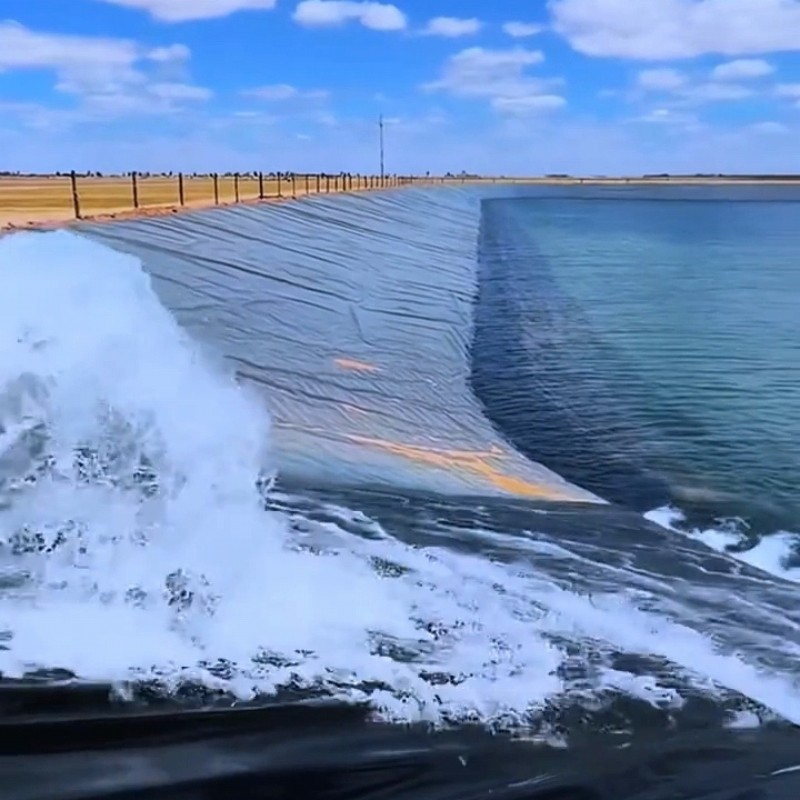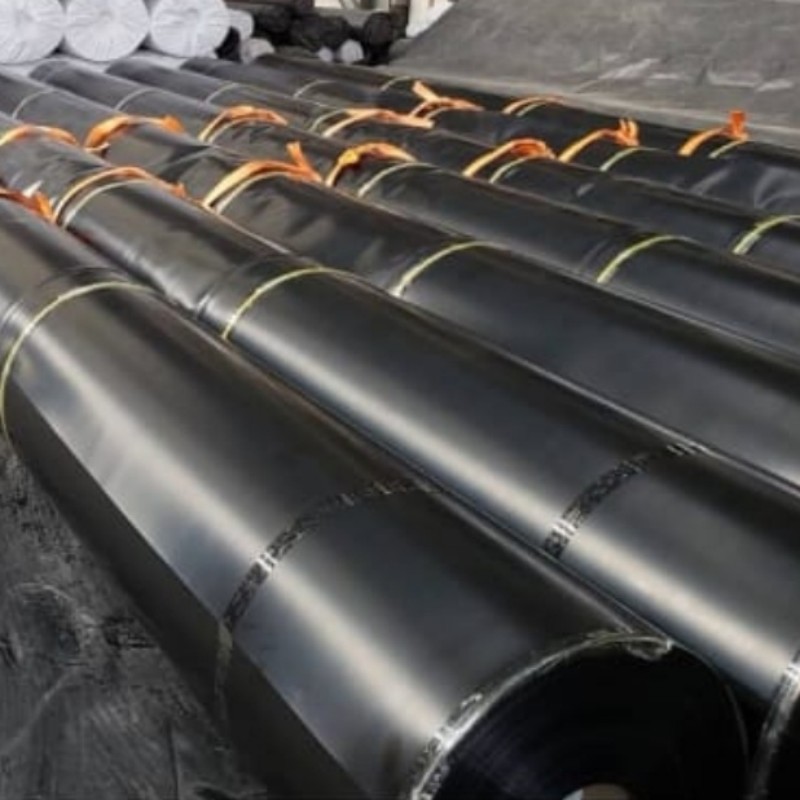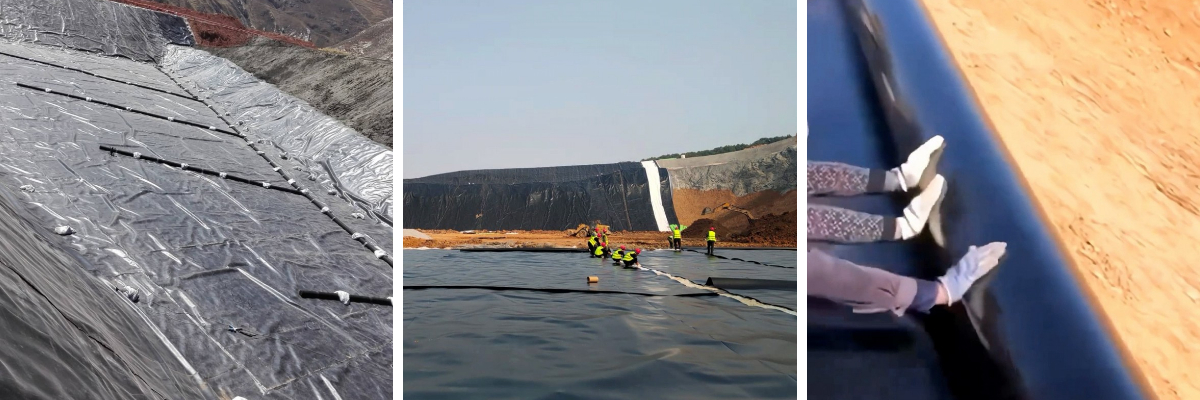HDPE Pond Liner for Aquaculture and Agriculture
1.Superior Waterproofing – Reliable anti-seepage protection.
2.Durable & Strong – High puncture and tear resistance.
3.UV Resistant – Withstands sunlight and outdoor exposure.
4.Safe for Aquaculture – Non-toxic, fish and plant friendly.
5.Chemical Resistant – Protects against acids, alkalis, and fertilizers.
6.Easy to Install – Flexible, quick, and low-maintenance.
In this article, we will explore why HDPE pond liners are so important, their key advantages, and how they contribute to sustainable aquaculture and agriculture.
What is an HDPE Pond Liner?
An HDPE pond liner is a geomembrane sheet designed to prevent water seepage in ponds, reservoirs, canals, and other water-retaining structures. It is manufactured using 100% virgin HDPE material, which provides outstanding resistance to punctures, chemicals, and UV radiation. Unlike traditional clay or concrete linings, HDPE liners offer superior performance with lower installation and maintenance costs.
For aquaculture and agriculture, these liners ensure that water is conserved, soil is protected, and aquatic life thrives in a safe environment.
Advantages of HDPE Pond Liner for Aquaculture and Agriculture
1. Superior Waterproofing
The primary purpose of a pond liner is to stop seepage, and HDPE excels at this. It creates an impermeable barrier that prevents water loss, ensuring stable water levels in fish ponds, irrigation reservoirs, and farm water storage tanks.
2. High Durability and Strength
HDPE pond liners are designed to withstand mechanical stress. They are resistant to punctures, tearing, and root penetration, making them suitable for long-term use in demanding environments. With a lifespan of 20–30 years under proper installation, they provide reliable performance for farmers and aquaculture operators.
3. UV and Weather Resistance
Outdoor applications require materials that can survive direct sunlight and extreme weather conditions. HDPE liners are formulated with strong UV resistance, ensuring they do not crack, shrink, or degrade even under prolonged sun exposure.
4. Safe for Aquatic Life
Aquaculture systems require materials that are safe and non-toxic for fish, shrimp, and other aquatic species. HDPE pond liners are eco-friendly and do not release harmful chemicals into the water, maintaining a healthy growing environment.
5. Excellent Chemical Resistance
Agriculture often involves the use of fertilizers, pesticides, and other chemicals. HDPE liners provide outstanding resistance to acids, alkalis, and organic compounds, protecting water quality and preventing soil contamination.
6. Easy Installation and Low Maintenance
HDPE pond liners are flexible and easy to install using professional welding techniques. Once installed, they require minimal maintenance, reducing long-term costs for farmers and aquaculture businesses.
Applications in Aquaculture
In aquaculture, water quality and stability directly affect productivity. HDPE pond liners are widely used in:
Fish farming ponds – Retain water efficiently, reduce seepage, and create a controlled environment for breeding.
Shrimp farms – Prevent contamination from surrounding soil and reduce the risk of disease outbreaks.
Hatcheries – Provide a clean and stable water environment for sensitive aquatic life.
By ensuring proper water retention and preventing external pollutants, HDPE liners help farmers improve yields and reduce operational risks.
Applications in Agriculture
Agriculture requires reliable water storage and distribution systems to support crop growth. HDPE pond liners play a critical role in:
Irrigation reservoirs – Store large volumes of water without seepage losses.
Canals and ditches – Prevent water loss during distribution, ensuring efficient irrigation.
Farm water storage – Provide a dependable solution for drought-prone regions, securing water supply for crops year-round.
By minimizing water waste, HDPE liners support sustainable farming practices and help farmers adapt to climate challenges.
Environmental and Economic Benefits
The use of HDPE pond liners in aquaculture and agriculture is not only practical but also sustainable. By preventing water seepage, they conserve water resources, reduce the need for frequent refilling, and lower pumping costs. Their long service life reduces replacement expenses, making them a cost-effective investment.
From an environmental perspective, HDPE liners protect soil and groundwater from contamination by preventing leachate from fertilizers or aquaculture waste. This aligns with global efforts toward more eco-friendly farming practices.
No. | Item | Unit | Index | ||||||||
1 | Thickness | mm | 0.30 | 0.50 | 0.75 | 1.00 | 1.25 | 1.50 | 2.00 | 2.50 | 3.00 |
2 | Density | g/cm3 | ≧0.940 | ||||||||
3 | Tensile yield strength | N/mm | ≧4 | ≧7 | ≧10 | ≧13 | ≧16 | ≧20 | ≧26 | ≧33 | ≧40 |
4 | Tensile breaking strength | N/mm | ≧6 | ≧10 | ≧15 | ≧20 | ≧25 | ≧30 | ≧40 | ≧50 | ≧60 |
5 | Yield elongation | % | - | - | - | ≧11 | |||||
6 | Break Elongation | % | ≧600 | ||||||||
7 | Right-angle Tearing strength | N | ≧34 | ≧56 | ≧84 | ≧115 | ≧140 | ≧170 | ≧225 | ≧280 | ≧340 |
8 | Puncture strength | N | ≧72 | ≧120 | ≧180 | ≧240 | ≧300 | ≧360 | ≧480 | ≧600 | ≧720 |
9 | Carbon black content | % | 2.0~3.0 | ||||||||
10 | Dispersion of carbon black | - | There is not more than one level 3 in 10 data, and level 4 and level 5 are not allowed to exist. | ||||||||
11 | Oxidation induction time | min | ≧60 | ||||||||
12 | Low temperature impact embrittlement properties | - | Pass | ||||||||
13 | Water vapor permeability coefficient | g.cm/ (cm2.s.Pa) | ≦1.0*10-13 | ||||||||
14 | Dimensional stability | % | ±2.0
| ||||||||
Note | Technical performance indicators for thickness specifications not listed in the table are required to be performed by interpolation. | ||||||||||
Why Choose HDPE Pond Liners from a Reliable Supplier?
Not all pond liners are created equal. Choosing a trusted manufacturer ensures that the liner is made from 100% virgin raw materials, tested for strength and durability, and certified for safety. Reliable suppliers also provide professional guidance for installation, ensuring long-lasting performance.
The HDPE pond liner for aquaculture and agriculture is an essential solution for modern water management. With its superior waterproofing ability, durability, chemical resistance, and eco-friendly properties, it ensures reliable water storage and protection for both farmers and aquaculture operators.
By investing in high-quality HDPE pond liners, you not only secure your water resources but also support sustainable farming and aquaculture practices for years to come.
If you are looking for a dependable pond liner for your aquaculture or agricultural project, HDPE is the proven choice that delivers long-term value, safety, and efficiency.












